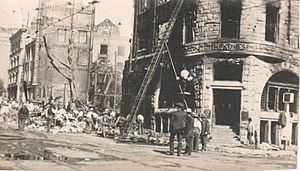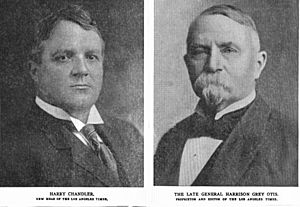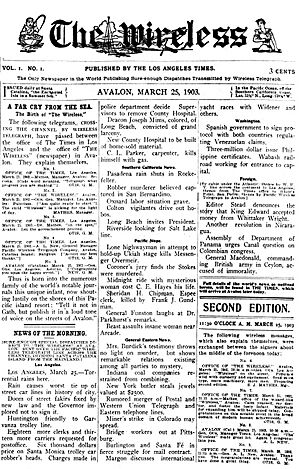Los Angeles Times facts for kids
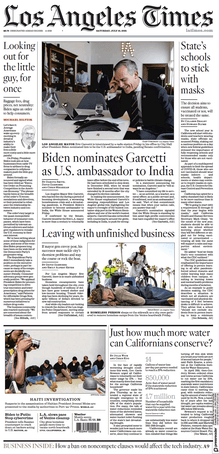
The front page of Los Angeles Times on July 10, 2021
|
|
| Type | Daily newspaper |
|---|---|
| Format | Broadsheet |
| Owner(s) | Los Angeles Times Communications LLC (Nant Capital) |
| Founder(s) | |
| Founded | December 4, 1881 (as Los Angeles Daily Times) |
| Language | English |
| Headquarters | 2300 E. Imperial Highway El Segundo, California 90245 |
| Country | United States |
| Circulation | 142,382 Average print circulation 105,000 Digital (2018) |
| ISSN | 0458-3035 (print) 2165-1736 (web) |
| OCLC number | 3638237 |
The Los Angeles Times is a major newspaper in the United States. It started publishing in Los Angeles, California, in 1881. Today, it is based in El Segundo, California. It is one of the largest newspapers in the U.S. and the biggest in the Western United States.
The paper has won many important awards, including over 40 Pulitzer Prizes. These awards are given for excellent journalism. In the past, the newspaper was known for promoting the growth of Los Angeles. It also had strong opinions against worker unions.
In 2018, the newspaper's staff decided to form a union. This was a big change after many years of the paper being against unions. The Los Angeles Times also moved its main office in 2018. It moved from downtown Los Angeles to El Segundo. Since 2020, the newspaper has focused more on news from California, especially Southern California.
In January 2024, the paper had to reduce its staff by more than 20%. This was done to help with financial challenges. Patrick Soon-Shiong, who owns the paper, announced in July 2025 that he planned to make the company public within a year. This means its shares would be traded on a stock market.
History of the Newspaper
Early Years and Growth
The Los Angeles Times first came out on December 4, 1881. It was first called the Los Angeles Daily Times. Nathan Cole Jr. and Thomas Gardiner started it. They printed it at the Mirror printing company.
Later, Harrison Gray Otis became the editor in July 1882. He also bought a part of the newspaper. Otis wanted the paper to help Los Angeles grow. He used the paper to support projects like bringing more water to the city from the distant Owens Valley.
The newspaper was very against worker unions. This led to a sad event on October 1, 1910. The newspaper's headquarters were bombed, and 21 people died. Two union leaders were charged with the crime.
The Chandler Family Era
After Otis passed away in 1917, his son-in-law, Harry Chandler, took over. Harry Chandler was followed by his son, Norman Chandler, in 1944. Norman led the paper during a time when Los Angeles grew very fast after World War II. Norman's wife, Dorothy Buffum Chandler, helped build the Los Angeles Music Center. A main concert hall there is named after her.
In 1935, the newspaper moved into a new, famous building. This building was in the Art Deco style. It was called the Los Angeles Times Building. The newspaper stayed there until 2018.
The fourth generation of the family, Otis Chandler, became publisher in 1960. He wanted the Los Angeles Times to be as respected as other big newspapers like The New York Times. He hired more reporters and paid them better. He also expanded the paper's news coverage to include national and international stories.
Otis Chandler also made the newspaper's opinions more balanced. Before, it was very conservative. During the 1960s, the paper won four Pulitzer Prizes. This was more than it had won in its first 90 years combined!
Modern Times
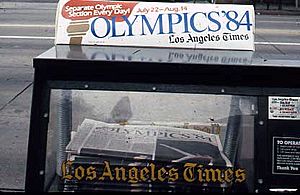
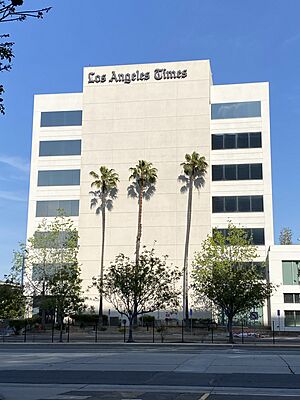
In the early 2000s, the Los Angeles Times faced many changes. It had different owners, financial problems, and many changes in its leadership. The number of people buying the print paper also went down. The newspaper needed to grow its online presence.
In July 2018, the newspaper moved to its new headquarters in El Segundo, California. This new building is close to the Los Angeles International Airport.
New Owners and Changes
In 2000, the company that owned the Los Angeles Times was bought by the Tribune Company. This company also owned the TV station KTLA.
In 2007, a businessman named Sam Zell bought the Tribune Company. This included the Los Angeles Times. In December 2008, the Tribune Company had to file for bankruptcy protection. This happened because of less advertising money and a lot of debt.
On February 7, 2018, Tribune Publishing sold the Los Angeles Times and two other newspapers to Patrick Soon-Shiong. He is a billionaire biotech investor. The sale was for $500 million. Soon-Shiong took over the paper on June 16, 2018. In July 2025, Soon-Shiong announced his plan to make the paper a public company within a year.
Staff Changes and Challenges
In 2000, John Carroll became the editor. He tried to improve the newspaper's quality. He cut over 200 jobs. Later, Dean Baquet became editor. He was the first African-American to hold such a high editorial position at a major newspaper. During their time, the paper won 13 Pulitzer Prizes.
However, Baquet left because he did not want to make more budget cuts. Other editors also left due to money disagreements. In July 2008, the paper announced plans to cut 250 jobs. This was about 17% of the news staff.
In January 2009, the paper combined its California/Metro section with the front section. It also cut 70 more jobs. In September 2015, Austin Beutner, the publisher, was replaced. More job cuts happened in October 2015.
On May 3, 2021, Kevin Merida was chosen as the new executive editor. He was a senior vice president at ESPN before this. He was also the first Black managing editor at The Washington Post.
The Los Angeles Times used to print its papers at a large facility on Olympic Boulevard. This plant closed in March 2024. Printing moved to Riverside, California.
In July 2023, the sports section changed. It stopped daily game coverage and box scores. Now, it has more magazine-style articles. On January 23, 2024, the newspaper announced another layoff affecting at least 115 employees. Terry Tang was named the new executive editor on April 8, 2024.
Newspaper Sales and Online Growth
The Times has seen a steady drop in the number of print copies sold. One reason is that more readers prefer to read the news online. Another reason was an increase in the paper's price.
In 2006, the Times closed its printing plant in the San Fernando Valley. Later, in 2010, the Orange County plant also closed. The daily circulation of the Times was 600,449 in October 2010. This was down from a high of over 1.2 million daily copies in 1990.
Online Presence
In December 2006, a group of Times reporters wrote a report about the paper's online news efforts. They said the paper was "web-stupid." This led to changes in how the website was managed.
In July 2007, the Times launched a website called Metromix. It focused on live entertainment for young adults. They also started a free weekly print version of Metromix. In 2009, Metromix was replaced by Brand X. This was a blog site and a free weekly paper for young, social media users. Brand X stopped publishing in 2011.
In May 2018, the Times blocked access to its online edition from most of Europe. This was because of new privacy rules in the European Union.
Other Notable Events
In 1999, it was found that the Times had a special money deal with the Staples Center. This was for a magazine about the arena's opening. The magazine's writers did not know about this deal. This was a problem because it mixed advertising with news reporting.
Michael Kinsley became the Opinion and Editorial editor in 2004. He tried to make opinion pieces stronger. In 2005, he created a "Wikitorial." This was a Wiki where readers could work together to write an editorial. It was shut down because it received inappropriate content.
In 2003, the Times published a story about gubernatorial candidate Arnold Schwarzenegger. This story caused a lot of discussion.
In November 2017, Walt Disney Studios stopped the Times from attending movie screenings. This was because of a report the paper published about Disney's influence in the Anaheim area. Many other news groups and writers supported the Times. They said Disney's action was against a free press. On November 7, 2017, Disney changed its mind.
In October 2024, the owner, Patrick Soon-Shiong, told the editor that the paper should not endorse a candidate in the 2024 United States presidential election. Instead, it should give a factual analysis of all candidates. The editorial board disagreed. Several members resigned in protest. Many subscribers also canceled their subscriptions. Soon-Shiong had also stopped an endorsement in 2020.
After the election, Soon-Shiong said he plans to add an AI-powered "bias meter" to articles. This would let readers see "both sides" of stories.
Pulitzer Prizes Won by the Times
The Los Angeles Times has won 41 Pulitzer Prizes as of 2024. These include awards for editorial cartoons and for covering major news events. For example, it won for its coverage of the 1965 Watts Riots and the 1992 Los Angeles riots.
Here are some examples of their Pulitzer Prize wins:
- In 1955, photographer John L. Gaunt Jr. won for his photo Tragedy by the Sea.
- In 1984, the paper won for its series called "Latinos".
- In 1990, sportswriter Jim Murray won a Pulitzer.
- In 1999, reporters Chuck Philips and Michael Hiltzik won for showing corruption in the music business.
- In 2001, David Willman won for his work on unsafe prescription drugs.
- In 2004, the paper won five prizes in one year. This is one of the most by any paper in a single year.
- In 2009, Bettina Boxall and Julie Cart won for their work on wildfires in the Western U.S.
- In 2011, Barbara Davidson won for her photos of gang violence victims.
- In 2016, the Times won for its coverage of the mass shooting in San Bernardino.
- In 2019, three reporters won for their investigation into a doctor accused of abusing students.
- In 2020, Christopher Knight won for his art criticism.
Newspaper Competitors
In the past, the Times had many rivals. In the 19th century, its main competitor was the Los Angeles Examiner. Later, in 1903, William Randolph Hearst started publishing the Los Angeles Examiner to compete directly with the Times.
By the mid-1940s, the Times was the most popular newspaper in Los Angeles. It even started its own afternoon paper, the Los Angeles Mirror, in 1948. This was to compete with other afternoon papers. Many of these rival papers eventually stopped publishing. The Los Angeles Herald-Examiner published its last issue in 1989.
In 2014, a new paper called the Los Angeles Register was launched to compete with the Times. However, it closed later that same year.
Special Editions and Local Papers
Midwinter and Midsummer Editions
For 69 years, from 1885 to 1954, the Times published a special "Midwinter Number" on New Year's Day. These editions celebrated the good things about Southern California. They were very large, sometimes with hundreds of pages. They were like a guide to the area.
Between 1891 and 1895, the Times also had a "Midsummer Number." These focused on the land and its fruits.
Local Editions and Subsidiaries
In 1903, the Times used a new wireless radio link to start a local daily paper in Avalon, California. This paper, called The Wireless, shared local news and stories sent by Morse code from the main paper. It only lasted about a year.
In the 1990s, the Times published different versions of its paper for specific areas. These included editions for the San Fernando Valley, Ventura County, and Orange County. These local sections stopped publishing in 2000.
The Times also owns other local newspapers. These include the Daily Pilot in Newport Beach. It used to publish the Glendale News-Press and Burbank Leader until 2020.
Newspaper Features
One special feature of the Times was "Column One." This appeared daily on the front page. It was known for interesting and sometimes unusual stories. The goal was to make readers say, "Gee, that's interesting, I didn't know that!"
The Times also does a lot of investigative journalism. This means they dig deep into important topics. For example, a series of stories in 2004 about the King/Drew Medical Center in Los Angeles won a Pulitzer Prize. Another series on Skid Row in Los Angeles became a movie called The Soloist.
From 1967 to 1972, the Times had a Sunday magazine called West. It was known for its cool art design. From 2000 to 2012, the Los Angeles Times Magazine was a weekly or monthly supplement. It focused on people, places, and culture in Los Angeles.
In 2024, the Times published an "L.A. Influential" series. It featured important people in the city, like artists and community leaders.
Promoting the Newspaper
Festival of Books

Since 1996, the Times has hosted an annual Los Angeles Times Festival of Books. This event brings together authors, readers, and publishers. It has discussions, exhibits, and stages. It is held over two days each April. In 2011, the festival moved to the University of Southern California.
Book Prizes
Since 1980, the Times has given out annual book prizes. These awards recognize great books in different categories. Categories include fiction, history, poetry, and young adult fiction. There is also a special award for authors connected to the American West.
Sports Events
The Times also sponsored some big sports events in the past. From 1974 to 1980, it sponsored the Los Angeles Times 500. This was a NASCAR stock car race held in Ontario, California. From 1957 to 1987, it sponsored the Los Angeles Times Grand Prix. This was a car race held in Moreno Valley, California.
Other Media Ventures
Book Publishing
The company that owned the Times, Times Mirror Corporation, also owned several book publishers. These included New American Library and C.V. Mosby Company. They published many different types of books, from classics to medical texts. Most of these book publishers were later sold.
Broadcasting Activities
|
Formerly
|
KTTV, Inc. (1947–1963) |
|---|---|
| Private | |
| Industry | Broadcast television Media |
| Fate | Acquired by Argyle Television (sold to New World Communications in 1994) |
| Founded | December 1947 |
| Defunct | 1993 |
| Headquarters | , |
|
Area served
|
|
| Products | Broadcast and cable television |
| Parent | The Times-Mirror Company (1947–1963, 1970–1993) Silent (1963–1970) |
The Times-Mirror Company also owned television stations. It was one of the first owners of TV station KTTV in Los Angeles, which started in 1949. They also bought other TV stations in cities like Dallas and St. Louis.
The company also got into cable television. They had cable systems in areas like Phoenix and San Diego. These cable systems were later sold in the mid-1990s.
TV Stations Owned
| City / Market | Station | Channel | Years owned | Current status |
|---|---|---|---|---|
| Birmingham | WVTM-TV | 13 | 1980–1993 | NBC affiliate |
| Los Angeles | KTTV 1 | 11 | 1949–1963 | Fox owned-and-operated |
| St. Louis | KTVI | 2 | 1980–1993 | Fox affiliate |
| Elmira, New York | WETM-TV | 18 | 1980–1986 | NBC affiliate |
| Syracuse, New York | WSTM-TV | 3 | 1980–1986 | NBC affiliate |
| Harrisburg - Lancaster - Lebanon - York |
WHTM-TV | 27 | 1980–1986 | ABC affiliate |
| Austin, Texas | KTBC-TV | 7 | 1973–1993 | Fox owned-and-operated |
| Dallas - Fort Worth | KDFW-TV 2 | 4 | 1970–1993 | Fox owned-and-operated |
Notes:
- 1 Co-owned with CBS until 1951.
- 2 Purchased with radio stations KRLD-AM and FM.
People Who Worked at the Times
Unionization of Staff
On January 19, 2018, employees in the news department voted to join a union. This was a big moment because the newspaper had been against unions for over a century. The vote was 248 in favor and 44 against.
Writers and Editors
- Dean Baquet, editor
- Martin Baron, assistant managing editor
- James Bassett, reporter, editor
- Skip Bayless, sportswriter
- Barry Bearak, reporter
- Jim Bellows, editor
- Sheila Benson, film critic
- Martin Bernheimer, music critic, 1982 Pulitzer Prize
- Bettina Boxall, reporter, 2009 Pulitzer Prize
- Jeff Brazil, reporter
- Harry Carr, reporter, columnist, editor
- John Carroll, editor
- Julie Cart, reporter, 2009 Pulitzer Prize
- Charles Champlin, film critic
- Sewell Chan, editor of the editorial page
- Michael Cieply, entertainment writer
- Shelby Coffey III, editor
- K. C. Cole, science writer
- Michael Connelly, crime reporter, novelist
- Thomas Curwen, reporter
- Borzou Daragahi, Beirut bureau chief
- Manohla Dargis, film critic
- Meghan Daum, columnist
- Anthony Day, op-ed writer, editor
- Frank del Olmo, reporter, editor
- Al Delugach, reporter
- Barbara Demick, Beijing bureau chief, author
- Robert J. Donovan, Washington bureau chief
- Mike Downey, columnist
- Bob Drogin, national political reporter
- Roscoe Drummond, syndicated columnist
- E. V. Durling, columnist
- Bill Dwyre, sports editor and columnist
- Braven Dyer, sports reporter, sports editor
- Louis Dyer, reporter, editor
- William J. Eaton, correspondent
- Richard Eder, book critic, 1987 Pulitzer Prize
- Gordon Edes, sportswriter
- Helene Elliott, sports columnist
- Leonard Feather, jazz critic
- Dexter Filkins, foreign correspondent
- Frank Finch, sportswriter
- Nikki Finke, entertainment reporter
- Thomas Francis Ford, editor, City Council member
- Douglas Frantz, managing editor
- Jeffrey Gettleman, Atlanta bureau chief
- Jonathan Gold, food writer, 2007 Pulitzer Prize
- Patrick Goldstein, film columnist
- Carl Greenberg, political writer
- Jean Guerrero, opinion columnist
- Joyce Haber, gossip columnist
- Bill Henry, columnist
- Robert Hilburn, music writer
- Shani Olisa Hilton, deputy managing editor
- Michael Hiltzik, investigative reporter, 1999 Pulitzer Prize
- Hedda Hopper, Hollywood columnist
- L. D. Hotchkiss, editor
- Pete Johnson, rock critic
- David Cay Johnston, reporter
- Jonathan Kaiman, Asia correspondent
- K. Connie Kang, first female Korean American journalist
- Philip P. Kerby, 1976 Pulitzer Prize
- Ann Killion, sportswriter
- Grace Kingsley, film columnist
- Michael Kinsley, op-ed page editor
- Christopher Knight, art critic, 2020 Pulitzer Prize
- William Knoedelseder, business writer
- Howard Lachtman, literary critic
- David Lamb, correspondent
- David Laventhol, publisher
- David Lazarus, business columnist
- Rick Loomis, photojournalist, 2007 Pulitzer Prize
- Stuart Loory, White House correspondent
- Steve Lopez, columnist
- Charles Fletcher Lummis, city editor
- Davan Maharaj, former managing editor, editor-in-chief and publisher
- Al Martinez, columnist
- Andres Martinez, op-ed page editor
- Dennis McDougal, reporter
- Usha Lee McFarling, reporter, 2007 Pulitzer Prize
- Kristine McKenna, music journalist
- Mary McNamara, TV critic, 2015 Pulitzer Prize
- Doyle McManus, Washington bureau chief
- Charles McNulty, theater critic
- Alan Miller, 2003 Pulitzer Prize
- T. Christian Miller, investigative journalist
- Kay Mills, editorial writer
- Carolina Miranda, arts and culture critic
- J.R. Moehringer, feature writing, 2000 Pulitzer Prize
- Patt Morrison, columnist
- Suzanne Muchnic, art critic
- Kim Murphy, assistant managing editor, 2005 Pulitzer Prize
- Jim Murray, sports columnist, 1990 Pulitzer Prize
- Sonia Nazario, feature writing, 2003 Pulitzer Prize
- Dan Neil, columnist, 2004 Pulitzer Prize
- Chuck Neubauer, investigative journalist
- Ross Newhan, baseball writer
- Jack Nelson, political reporter, 1960 Pulitzer Prize
- Anne-Marie O'Connor, reporter
- Nicolai Ouroussoff, architectural critic
- Scot J. Paltrow, financial journalist
- Olive Percival, columnist
- Bill Plaschke, sports columnist
- Michael Parks, foreign correspondent, editor, 1987 Pulitzer Prize
- Russ Parsons, food writer
- Mike Penner, sportswriter
- Chuck Philips, investigative reporter, 1999 Pulitzer Prize
- Michael Phillips, film critic
- Charles T. Powers, foreign correspondent, novelist
- George Ramos, reporter
- Richard Read, reporter, 1999 Pulitzer Prize, 2001 Pulitzer Prize
- Ruth Reichl, restaurant and food writer
- Rick Reilly, sportswriter
- Lisa Richardson, editorial writer
- James Risen, investigative journalist
- Howard Rosenberg, TV critic, 1985 Pulitzer Prize
- Tim Rutten, columnist
- Harriet Ryan, Pulitzer Prize-winning investigative reporter
- Ruth Ryon, real estate writer
- Morrie Ryskind, feature writer
- Kevin Sack, 2003 Pulitzer Prize
- Ruben Salazar, reporter, correspondent
- Robert Scheer, national correspondent
- Lee Shippey, columnist
- David Shaw, 1991 Pulitzer Prize
- Gaylord Shaw, reporter, 1978 Pulitzer Prize
- Gene Sherman, reporter, 1960 Pulitzer Prize
- Barry Siegel, feature writing, 2002 Pulitzer Prize
- T. J. Simers, sports columnist
- Jack Smith, columnist
- Cecil Smith, features writer, critic
- Bob Sipchen, editorial writing, 2002 Pulitzer Prize
- Frank Sotomayor, reporter, editor
- Bill Stall, editorial writing, 2004 Pulitzer Prize
- Joel Stein, columnist
- Jill Stewart, reporter
- Rone Tempest, investigative reporter
- Kevin Thomas, film critic
- William F. Thomas, editor
- Hector Tobar, columnist, book critic
- William Tuohy, foreign correspondent, 1969 Pulitzer Prize
- Kenneth Turan, film critic
- Julia Turner, deputy managing editor
- Peter Wallsten, national political reporter
- Matt Weinstock, columnist
- Kenneth R. Weiss, 2007 Pulitzer Prize
- Nick Williams, editor
- David Willman, 2001 Pulitzer Prize
- Michael Wines, correspondent
- Jules Witcover, Washington correspondent
- Gene Wojciechowski, sportswriter
- Willard Huntington Wright, literary editor
- Jeanne Voltz, food editor
- Kimi Yoshino, managing editor
Cartoonists
- Paul Francis Conrad, Pulitzer Prize in 1964, 1971, and 1984
- Ted Rall
- David Horsey, Pulitzer Prize in 1999 and 2003
- Frank Interlandi
- Michael Patrick Ramirez, Pulitzer Prize in 1994 and 2008
- Bruce Russell, Pulitzer Prize in 1946
Photographers
- Don Bartletti, Pulitzer Prize in 2003
- Carolyn Cole, Pulitzer Prize in 2004
- Rick Corrales, photographer
- Mary Nogueras Frampton, one of the paper's first female photographers
- Jose Galvez, photographer
- John L. Gaunt Jr., Pulitzer Prize in 1955
- Rick Loomis, photojournalist, 2007 Pulitzer Prize
- Anacleto Rapping, multiple Pulitzer Prizes
- George Rose, photojournalist
- George Strock, photojournalist
- Annie Wells, photojournalist
- Clarence Williams, Pulitzer Prize in 1998
See also
 In Spanish: Los Angeles Times para niños
In Spanish: Los Angeles Times para niños


